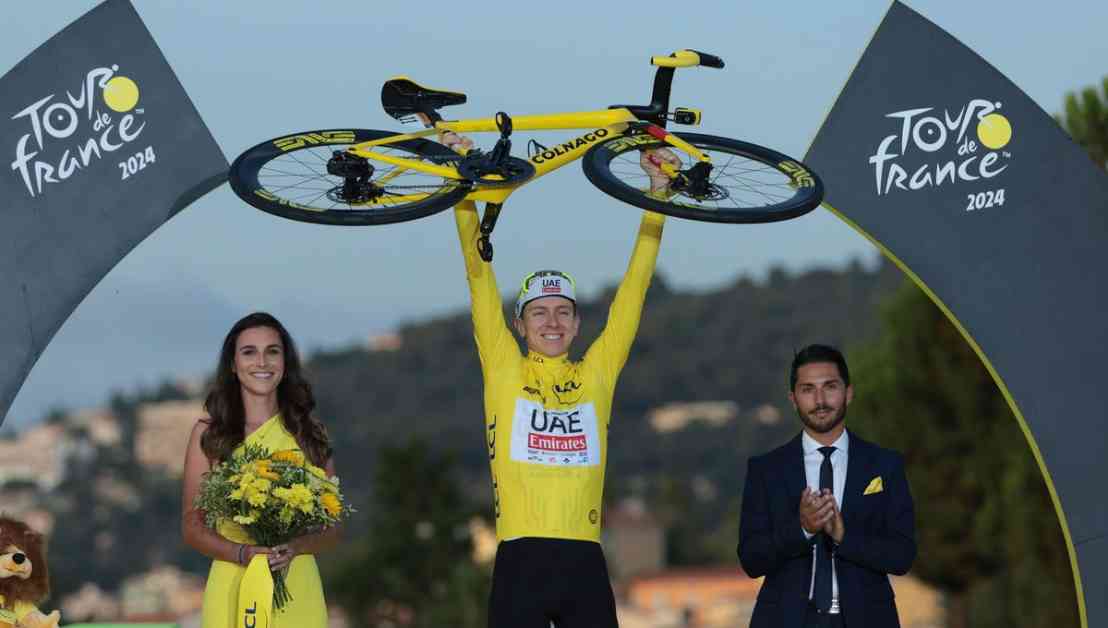When did they stop thinking they could catch him? Last summer, during the Tour de France? During the World Championships in Zurich in September? In any case, during the Tour of Lombardy on October 12, no one believed it anymore. “99% of the teams think Pogacar will win, so do we,” said Frenchman David Gaudu. 2024 is Pogacar’s year. The 26-year-old Slovenian has won nine of the eleven races he has entered. The Giro d’Italia, Tour de France, World Championships, Tour of Lombardy, Strade Bianche (Italian race), and the Tour of Catalonia… Each time, Pogacar crushed his opponents, even breaking away 100 kilometers from the finish at the World Championships in Zurich, which was unheard of, especially on a course with a 4,470-meter elevation gain! Journalist Fanny Lechevestrier, who covers cycling for Radio France, recalls the last Tour de France. “During the 14th stage, Pogacar climbed Pla d’Adet [in the Pyrenees] at an average speed of nearly 22 km/h. In the final nine kilometers of the climb, he broke Lance Armstrong’s 2001 record. So naturally, it’s a topic of conversation.” The skepticism surrounding these extraordinary performances is widespread but often voiced anonymously. The cycling world isn’t always as friendly as it seems, and many remember the isolation of Christophe Bassons in the late 90s when he denounced doping in the peloton. “We, the doctors, observe how a rider breathes during the race, mouth closed or mouth open,” says a doctor who worked for several years in a French World Tour team. “If his mouth is closed, it means oxygenation is perfectly ensured. Pogacar on the Giro made me lose interest in watching cycling. In the last few hundred meters, he was in a state of freshness incompatible with the energy expended.” These doubts are not shared by Alexys Brunel. The French rider, who has just signed with TotalEnergies for the upcoming season, knows Pogacar well. They are the same age, 26, and have been together since the juniors, the hopes, and then at UAE Emirates, the Emirati team where the Slovenian has been since 2019. “I would have questioned things if, when I was at UAE, I hadn’t progressed myself,” he says. “Thanks to their training techniques, I was 50 watts stronger [watt/kilo is the unit of power measurement in cycling] over 25 minutes and 25 watts stronger over 20 minutes!” So what is this miracle recipe? “At UAE, we train and pedal differently. When I joined them, my overall training volume decreased. But there was much more intensity and the exercises were longer.” Another lever for improvement is bike position. “We worked a lot on that,” continues Alexys Brunel. “Changing the stem [the part of the bike that supports the handlebars], the length, and size of the frame. Nothing is left to chance at UAE, which is why Tadej’s performances don’t surprise me.” An improvement in equipment “not sufficient” to explain the performance gap Without commenting on Pogacar’s specific case, Maxime Robin, the performance director at TotalEnergies, confirms that “significant progress has been made in terms of aerodynamics.” “The jersey fabric is studied, but also the helmet, glasses, gloves… All the parameters of the human body and the bike are scrutinized to be as aerodynamic as possible,” explains Maxime Robin, who wrote a thesis on maximal power production in cycling. So, is there nothing to see here? “These elements are not sufficient to explain the performance gap,” reacts Emmanuel Brunet, research and performance manager at the French Cycling Federation (FFC). “Among the World Tour teams, almost everyone has roughly the same type of tires, bike, or outfit. Virtually everything is made in the same place.” The manager believes that “if there is a difference, it probably comes from genetics.” Pogacar, but also the Dane Jonas Vingegaard, whose results have also raised suspicions, would have “different genetics.” After the Tour de France 2023, which he dominated, Vingegaard said to the press, “It must be genetic.” “What puzzles us,” retorts Emmanuel Brunet, “is that we didn’t notice this different genetics when they were riding in the junior and hopeful categories.” Pogacar did finish third in the Junior European Championships in 2016, but “he didn’t crush the competition like he does today,” recalls the FFC’s performance manager. The questioning is even stronger for Vingegaard, who “evolved as a junior in relative anonymity,” according to Emmanuel Brunet. In any case, Pogacar dismisses the suspicions. During a press conference last October at the Tour of Lombardy, the Slovenian stated that “if you want to risk [your] health and [your] life for years of a career, it’s stupid.” And he added: “There are always people who are jealous, suspicious, and we can’t do anything about that.” The Armstrong precedent Few riders openly voice their doubts within the peloton. But among the French, there is an acknowledgment of a shift. “There was a before and after Covid. The level has really increased a lot,” said Warren Barguil in an interview with Ouest France last June. “Sometimes, you have to be at 100% just to try to keep up…” This is also the opinion of Guillaume Martin, who will leave Cofidis for Groupama-FDJ next season. “In my early professional years in 2016/2018, with a power of 6.5 watts per kilo over a certain duration, I could almost play for victory. Today, that’s barely enough to make the top 10 or top 15,” says the climber, who finished 13th in the Tour de France 2024. And yet, neither Pogacar nor Vingegaard, nor those currently at the top of the world rankings, have tested positive for a banned substance or been involved in a doping case. “Armstrong in his time was tested negative 500 times,” reminds former rider and manager Roger Legay, now president of the Movement for Credible Cycling (MPCC), to the naive. “And yet, he was the biggest cheater in all sports.” The specter of genetic doping In general, positive controls – and thus sanctions – are rare in cycling. In recent years, the International Cycling Union (UCI) has suspended an average of five riders per year out of 1000 professional road cyclists. Suspensions for testing positive for a prohibited substance or due to anomalies in a rider’s biological passport. We are far from the 90s and 2000s when large swathes of the peloton were caught. So has cycling become 100% clean, or is there a substance that would slip under the radar? “Pharmacology and human nature being what they are, it would be very naive to think that cycling has become entirely clean,” says Professor Olivier Rabin, director of science and medicine at the World Anti-Doping Agency (WADA). “We must remain extremely vigilant about athletes’ ability to access new substances or new doping methods.” According to Olivier Rabin, the threat of genetic doping is “much more real” than it was a few years ago. It is nothing less than a diversion of gene therapy used in medical settings. “In concrete terms, genetic doping could be the addition of an additional gene for EPO or growth hormone,” explains Olivier Rabin. These are hormones naturally present in the human body, but by stimulating their production. Genetic doping could also involve “modifying gene expression by adding messenger RNAs to produce more proteins,” according to Olivier Rabin. Science fiction? Not according to WADA. “In the United States, biohackers manipulate genetic sequences to administer them to animals or humans. This is the reality of the world we live in, and we must be prepared for this threat.” Not all generic EPOs are detectable Anti-doping authorities also have their sights set on so-called generic EPOs, manufactured in China and India. “We should have the ability to detect them,” says the director of science and medicine at WADA. “But there are many of them. When we started 25 years ago, only one EPO (synthetic) was manufactured. Today, there are dozens, even hundreds worldwide.” WADA orders them online to analyze them in the laboratory and then develop a test to detect them. “But to say that all these generic EPOs are detectable would be a bit presumptuous; it would mean that we have tested them all.” Some products are microdosed… Among the products used by riders who have tested positive recently, there seems to be a sense of déjà vu: CERA (third-generation EPO) in a Kazakh cyclist, anabolic steroids to increase muscle mass in Argentine, Uzbek, and Dutch riders, and a suspicion of blood transfusion in French rider Franck Bonnamour, who, contacted by the Radio France investigation unit, categorically denies doping. If we add growth hormones to this list, we see that the substances are the same as in the 90s and 2000s. And for a good reason: human physiology has not changed, and the goal remains to enhance endurance and oxygen transport to the muscles through these products. The substances are the same, but the injected doses are reduced. “We are no longer in the old-fashioned doping with large doses that are easily detected,” says Olivier Rabin from WADA. “These are daily injections, no longer three times a week. The doses are much lower, sometimes even administered intravenously.” Less easily detectable The interest for riders is to maintain a high production of red blood cells… while hoping to slip through the anti-doping net. The microdoses of doping substances remain in the blood and urine for a shorter time, making them more difficult to detect during controls. “The detection window for certain substances is very short,” confirms Olivier Banuls, head of the testing department at the International Testing Agency (ITA), the independent organization that conducts anti-doping controls. “Sometimes, this detection window doesn’t exceed a few hours.” The other “advantage” of microdoses is that they do not dramatically alter blood parameters. “The goal is not to leave traces in the profiles” as part of the biological passport monitoring, explains Jean-Pierre Verdy, former head of the testing department at the AFLD. “I noticed the difference. In the first profiles we examined, there were significant variations. Over time, as riders realized they were being caught, these discrepancies decreased to small oscillations.” Hence the difficulty, sometimes, in distinguishing a rider with minimal variations in their red blood cell count. Controlled at 8:00 pm… And at 6:45 am the next day The challenge for the ITA is to test riders very regularly. On average, during a competition, “each rider is tested four times,” explains Olivier Banuls. Most cyclists comply with these frequent controls. For example, during the last Vuelta (Tour of Spain), Guillaume Martin recalls that during the third week of the race, “a tester knocked on [his] door at 8:00 pm for a urine test.” “The next morning at 6:45 am, I was still asleep when there was another knock on my door, and the same tester returned for another urine test,” recalls the rider. “I later learned that these very close tests were specifically aimed at trying to catch mini-doses that could disappear very quickly from the body.” For Guillaume Martin, these controls are necessary “to find possible cheaters who undoubtedly still exist, even though this sport has been greatly cleaned up.” However, has the world of cycling exorcised its demons? Some doubt it. The website cyclisme-dopage.com, created by a cycling enthusiast and well-informed, specializes in refreshing memories. It regularly scrutinizes the organizational structure of the 18 World Tour teams and Pro Teams. The observation is crystal clear: many riders whose names have been mentioned in doping cases have reconverted into coaching roles. The Mauro Gianetti case The most emblematic case is that of Swiss Mauro Gianetti, the manager of UAE Emirates, Pogacar’s team. A former professional rider, he suffered a seizure during the Tour de Romandie in 1998 and was in a coma for three days. Le Monde newspaper revealed at the time that he had injected himself with perfluorocarbon (PFC), which improves oxygen transport in the blood. Mauro Gianetti has always denied this, but his former teammate, Frenchman Eric Boyer, questions it. “I know Mauro well. I roomed with him in 1995 when we were riders at Polti,” begins the former Cofidis manager. “He was a professional cyclist for ten years. He never won a single race. And then, just like that, one year, he won major races,” says Eric Boyer. After a rather discreet start to his career, Mauro Gianetti won the prestigious Liège-Bastogne-Liège and Amstel Gold Race in 1995. “I remember the conversations I had with him. He’s a nice and pleasant person, but he doesn’t consider practicing cycling without medical performance support.” Contacted, Mauro Gianetti declined to comment on these statements. “I find it irresponsible” Other teams have placed riders with questionable pasts in leadership positions. Kazakh Alexander Vinokourov is now the general manager of Astana. During the 2007 Tour de France, he tested positive for blood transfusions. He too has always denied doping. “It’s a shame that we don’t have the legal means to tell riders who have tested positive, ‘what you did is too serious, you cannot lead a team.’ I think it’s irresponsible to let them lead,” says Eric Boyer, former Cofidis manager. Riders “stuffed” with medication” Irresponsible” is also how many of our interviewees describe the tendency to “stuff riders with medication.” During our investigation, we spoke with several professional riders on this issue, and all acknowledge that a veritable “medicine cabinet” is made available to them, with the onus on them to use it or not. A French rider mentions a combination of Voltaren [anti-inflammatory], caffeine, and paracetamol, dubbed the “bomb,” in reference to the amphetamine cocktail that circulated in the peloton in the past. Another rider recalls the multitude of medications offered by the team staff. “In the bus of my former team, in the morning before the start of races, there was what we called the magic box,” he says. “There was paracetamol, caffeine, theophylline [a respiratory stimulant], thiocolchicoside [with anti-inflammatory and analgesic effects]. Riders who wanted to could use them. It bothered me; it’s not my mindset,” he says, while adding, “Anyway, it’s not thanks to this that some riders are climbing mountains three times faster than they were 20 years ago!” A “dietary supplement” that enhances recovery In addition to these authorized medications, there is a trend in the peloton for the use of synthetic ketones, which has been ongoing for some time. This small bottle of liquid that riders consume after races is said to enhance physical performance, sharpen mental acuity, and improve recovery, according to one of the main manufacturers, Delta G Ketones. The Soudal-Quick Step team (with Belgian Remco Evenepoel and Frenchman Julian Alaphilippe), Alpecin Deceuninck, and Visma Lease a Bike (where Jonas Vingegaard rides) openly use them. The first two have even entered into partnerships with manufacturers. “Ketones are a dietary supplement. You can use them like vitamins,” said Richard Plugge, the manager of Visma, a few years ago. Are ketones just a dietary supplement? The topic is debatable. According to Belgian and British studies published in 2023, ketone ingestion increases “endogenous EPO concentration,” thus red blood cell volume. One of the latest studies demonstrates that ketones improve post-exercise recovery and sleep quality. This is highly relevant in a stage race like the Tour de France. The UCI, which we contacted, says it is awaiting the results of its own investigation launched in 2021 to make a statement. For now, it advises riders against taking ketones. The same position is held within the MPCC, the Movement for Credible Cycling. “We discourage the use of ketones,” says Roger Legeay, the president of the MPCC. “It is used in the peloton, we know that. But for us, you should not take them.” The rider buys, the team supervises This warning does not prevent some French teams, which have signed the MPCC charter, from tolerating or even supervising their use. A rider from Decathlon AG2R La Mondiale asserts that “during the preseason training camp in December 2023 in Spain, the team doctor offered them. And the manager was aware. For me, it’s doping, it makes me very uncomfortable.” An agent of riders confirms, speaking anonymously, the widespread use of ketones within French teams. “No team is spared from the ketone phenomenon. Including those who are members of the MPCC,” he says. “It is even medically organized within the teams. The teams do not pay for the ketones themselves because it is too expensive, but they supervise their use.” A ketone bottle costs an average of 30 dollars. At one bottle per person per day of racing, this represents a significant budget. It is often the rider who pays, confirms a French cyclist. “The managers tell us that it is better to have supervision rather than haphazard use,” he says. “But it’s exactly the same argument we heard in the 90s, the famous: ‘doping is so widespread that we have regulated it!'” The Radio France investigation unit contacted the French teams mentioned in these testimonies (Decathlon-AG2R La Mondiale, Arkea BNB Hotels, Groupama-FDJ, and Cofidis). Except for the latter, which did not respond, the French teams acknowledge for the first time that “some” of their riders use ketones “individually,” that it is indeed “the riders who buy the bottles,” and that they only provide “medical follow-up” for what they consider a “dietary supplement.” “More productive on the bike” According to French rider Alexys Brunel, who used ketones “once during training,” this product is far from being a miracle solution. “Obviously, it must serve a purpose. In terms of recovery, I think it plays a role because riders take a lot of it after stages and not during,” he testifies. “But these are marginal gains. It’s not what will win you the Tour de France or even a stage. However, it might make you mentally more or less productive and therefore more productive on the bike.” In any case, WADA has no plans to ban them “in the near future.” “Ketones certainly help with weight loss and improve the weight/power ratio,” says Olivier Rabin, WADA’s director of science and medicine. “But no more so than following a diet.” Medical equipment repurposed for sports performance Within the peloton, never short of imagination, another device used by the leaders raises
Cycling: Suspected Doping and Abundant Medications in the Sport
706

















